The McLaren 750S Marks The End of an Era
If you stepped into a McLaren dealership back in 2017, you could have walked out with a car that very much looks and feels like the Mantis Green 750S I’m driving this week. While the 720S that preceded it now resides firmly in the pre-owned section of the showroom, the impact of its legacy on both the British marque’s reputation and the broader supercar space is still being felt.
The McLaren 720S marked a significant shift in the world of exotic cars. It represented the first time that a supercar’s performance veered into hypercar territory. Search through YouTube’s back catalog, and you’ll find no shortage of videos showing the 710-horsepower 720S demolishing practically anything pitted against it.
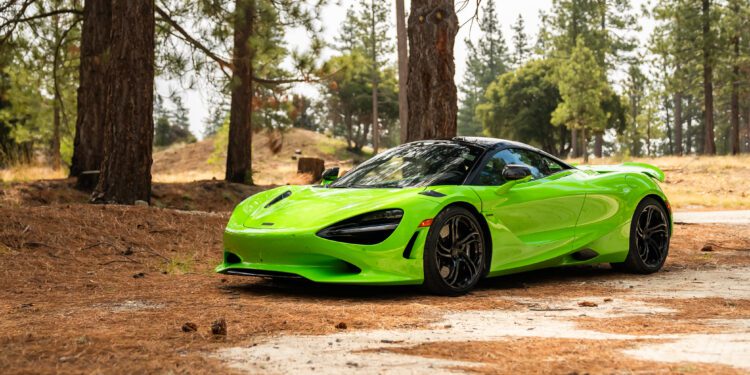
The McLaren 720S marked a significant shift in the world of exotic cars. It represented the first time that a supercar’s performance veered into hypercar territory. Search through YouTube’s back catalog, and you’ll find no shortage of videos showing the 710-horsepower 720S demolishing practically anything pitted against it.
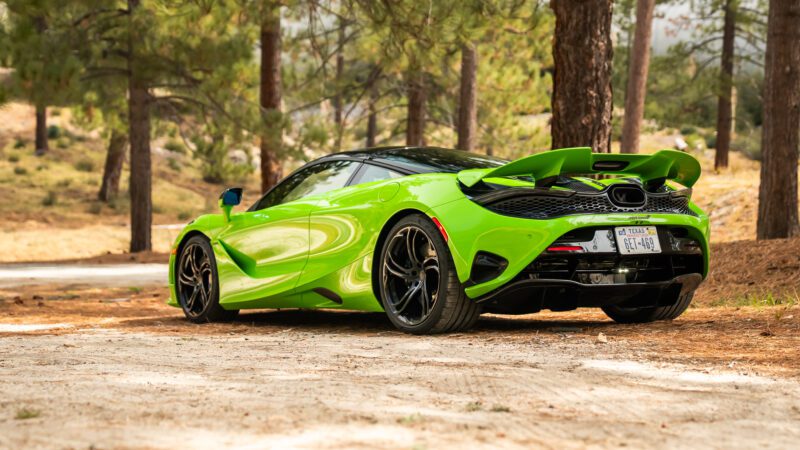
Recall that, at the time, a Ferrari 488 GTB produced 49 fewer horses at 661 hp while having to lug around more weight. The McLaren reduced its mass by adopting a carbon fiber structure, a component still reserved for Prancing Horses costing seven figures. And despite sending power to all four wheels, the 631-hp Lamborghini Huracan Performante couldn’t catch up. In case the Maserati MC20 comes to mind, it was just an idea in 2017, still wearing its original Alfa Romeo badge.
Ferrari’s response came a year later, in 2018, in the form of the 488 Pista. And if you have any doubts that the 720S was its intended target, take a peek at its 711-hp claimed output, just one over the McLaren’s. The F8 Tributo that followed inherited the Pista’s heart to remain competitive but, as such, didn’t make a significant performance leap. Woking’s over-achiever wasn’t completely dethroned until the rapid 818-hp 296 GTB arrived in 2021.
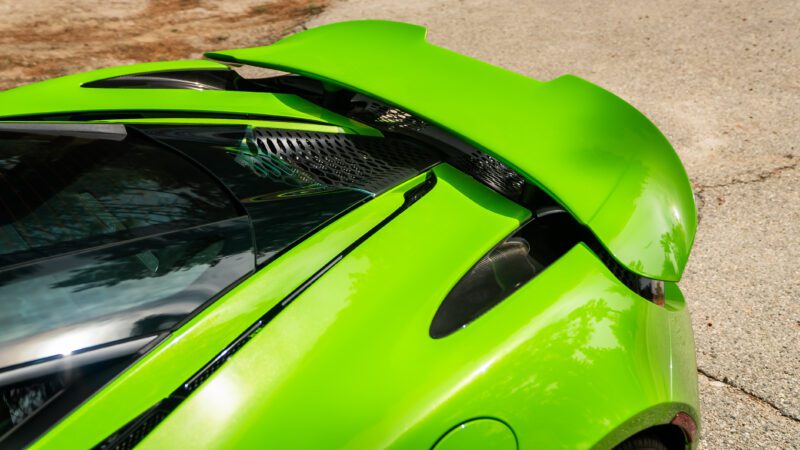
Lamborghini wasn’t quite as eager to turn up the power knob, remaining focused on delivering an experience rather than competing for the segment’s top spot. This wise decision yielded some of the best-sounding and most exciting supercars of the last decade, thanks mainly to the thrilling naturally-aspirated V10 that powered them. See the Huracan STO, Tecnica, and Sterrato.
The Raging Bull that will replace them, however, is a plug-in hybrid equipped with a 10,000-rpm twin-turbo V8 and three electric motors. Over in Maranello, the aforementioned 296 GTB also has a charging port, an electric motor, and an 8,500-rpm twin-turbo V6 at its center. While the folks over at Woking haven’t announced what comes after the 750S, it will most likely inherit a modified version of the W1’s 9,200-rpm twin-turbo V8 and electric motor plug-in hybrid combo.
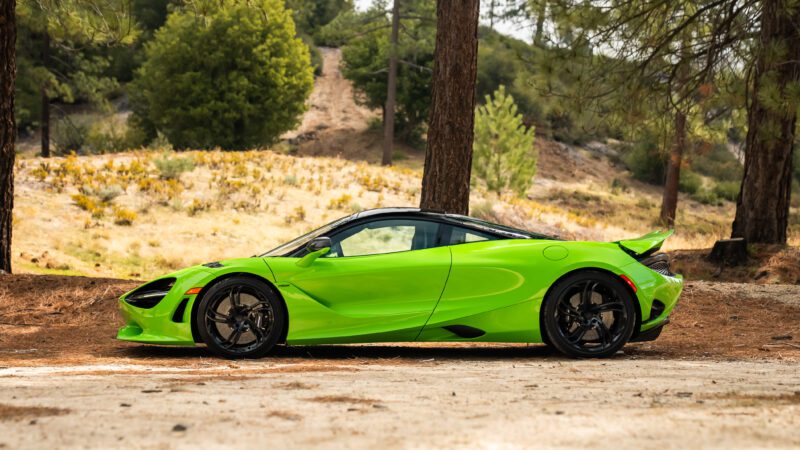
What we have now and in the near future is a consolidation of the supercar experience. While you can partly blame the tightening of emissions regulations, it’s clear that the 720S also pushed the horsepower wars to new heights. In fact, it was so ahead of its time that, when McLaren encountered repeated delays with the Artura program, the carmaker was able to borrow from the manic 765 LT, refresh the 720S, and still manage to compete for the industry’s top spot.
However, with more power comes the need for more advanced traction and stability systems to keep you on the road. Drive a supercar from the 1990s or the early 2000s, and you won’t be able to shake the feeling that it’ll bite back if not treated with respect. This fear is integral to creating a thrilling supercar experience. There has to be some element of danger, and it’s this very feeling that has been fading away as we enter the 2020s, with supercars across the board becoming ever friendlier and more tame.
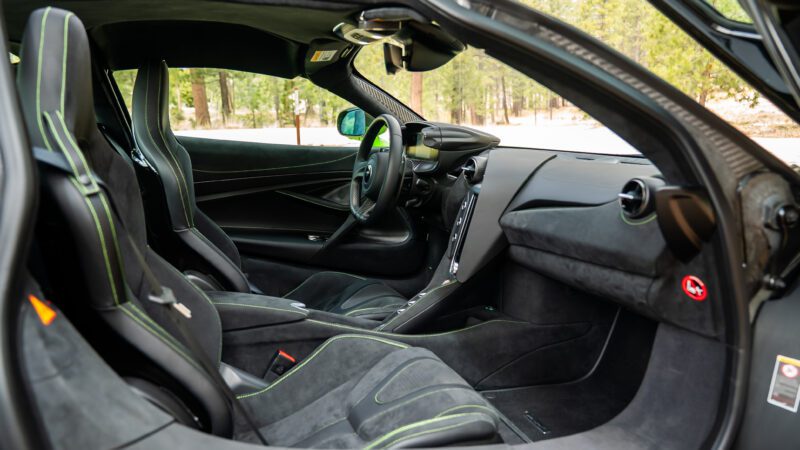
This Mantis Green McLaren 750S is far from the first I’ve ever driven. I won’t dive too deeply into its details, seeing as I covered it when it launched, and I road-tripped another from Monterey to Los Angeles last year. However, as I revisit it for the third time, the 750S remains the only supercar on sale that constantly warns that it will bite back if provoked.
While most modern exotics will allow you to dial back traction and stability control, these systems never truly disengage. You’ll be able to slide them around and light up their tires off the line, but there will always be an invisible helping hand. This is great if you want to feel like a hero behind the wheel, but not so much if having an engaging experience is the goal.
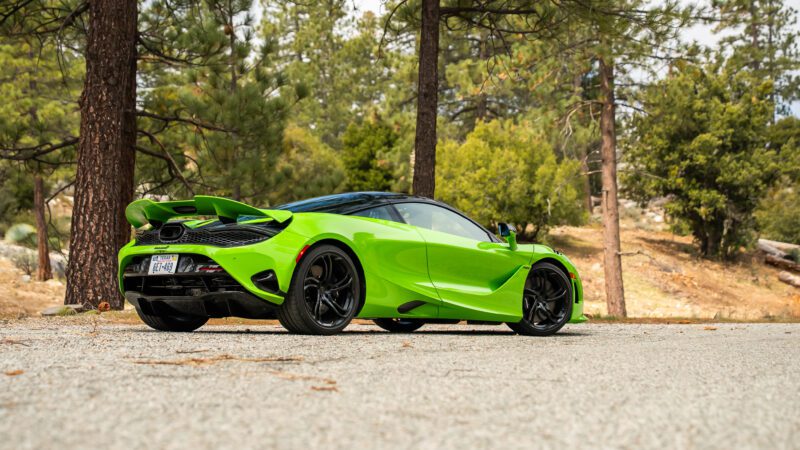
In contrast, while the McLaren 750S allows you to dial in your ideal yaw angle with its Variable Drift Control or progressively adjust its traction systems, it also leaves you feeling on your own with its software fully disengaged. Floor its accelerator without its guiding hand at play, and the 750S reveals a newfound edge to its persona. This newest iteration takes this a step further thanks to its shortened gears borrowed from the 765LT.
As you’d expect from a car that weighs a hair over 3,000 pounds and develops 740 hp and 590 pound-feet of torque from a 4.0-liter twin-turbocharged V8, its straight-line performance is as manic as it is impressive. However, this powertrain remains the least exciting part of this car. For one, it lags considerably if you’re not accelerating from high enough revs, and despite its exhaust system shooting blue flames, its note has an almost artificial tone that lacks any musicality.
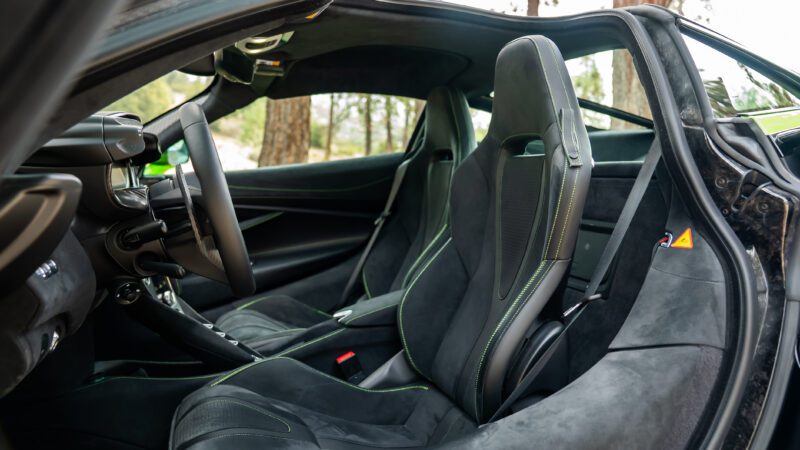
Please allow me to channel my inner Colin Chapman for a moment. The 750S is special because of its lack of weight and the abundance of feedback it provides its driver. Recall the 296 GTB? Despite it delivering a blistering performance both on the road and on the track, it weighs around 500 lb more than the McLaren. Truth is, batteries are heavy. The Temerario is even heftier with a curb weight of 3,725 lb, meaning it packs almost an extra 700 over Woking’s latest.
While modern tire and suspension technology are particularly capable of masking excess weight, nothing other than lightness manages to generate the behind-the-wheel sensation that enthusiasts crave. It’s the one thing that can’t be replicated and part of the reason why so many of us still keep a classic or two in our garages. In the words of French writer Antoine de Saint-Exupéry:
“To some, perfection is achieved when there is nothing more to add. To others, perfection is achieved when there is nothing left to take away.”
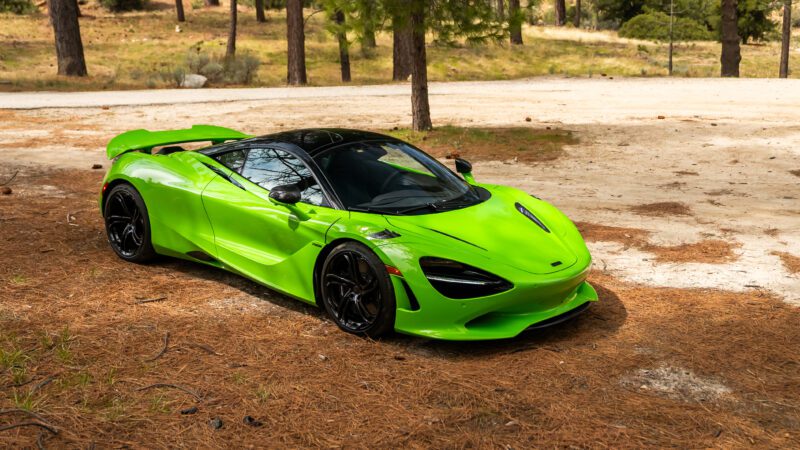
The McLaren 750S enhances the experience with its communicative hydraulic power steering, a high-effort brake pedal with minimal assistance, and the stiffness of its carbon fiber structure. It offers sensory overload in a way most modern cars can’t. Yet, because you can feel so much through its wheel and chassis, you can confidently push its limits with all of its systems dialed back. Should you overstep, you’ve all the information you need at your fingertips to recover.
This feeling of connectedness is fading in modern supercars. I’ve seen it gradually fade over the years I’ve focused on this industry, and if I had to guess, it’s about to get worse. New performance cars become more artificial with each new generation, and it’s for this very reason that the McLaren 750S marks the end of an era.
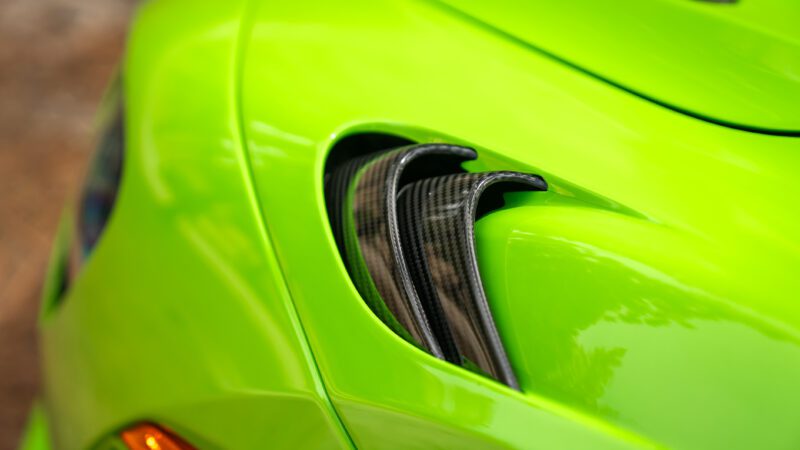
Sure, its replacement will likely retain much of its feel, as evidenced by the sensational Artura, but it will most likely gain some pounds in the process. And given that the W1’s V8 develops 915 hp on its own, the 750S’ successor will likely require a more attentive invisible hand to ensure its owners don’t veer off unintentionally.
The McLaren 750S isn’t the best car ever made. If that’s where you thought this was headed, I apologize. There are others within Woking’s back catalog better suited to fight for that title. However, it is the last of the truly intimidating supercars, bringing the chapter started by some of the best supercars ever made to a close.
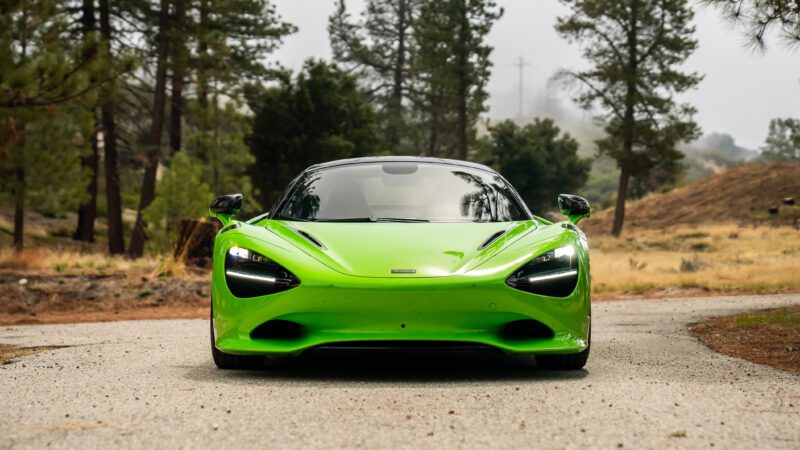
Due to its immense power, lack of excess weight, and rear-wheel drive, it requires a high level of effort from its driver to tackle a track or a mountain road at high speeds. To find a more engaging drive, you’d have to dabble in the restomod space or turn to machines built before the 2000s. As the next generation of supercars inches ever closer, the 750S serves as a reminder that a thrilling experience can’t be artificially recreated.
Gravity Shifts: First Drive In The 2026 Lucid Gravity
by Gabriel Vega
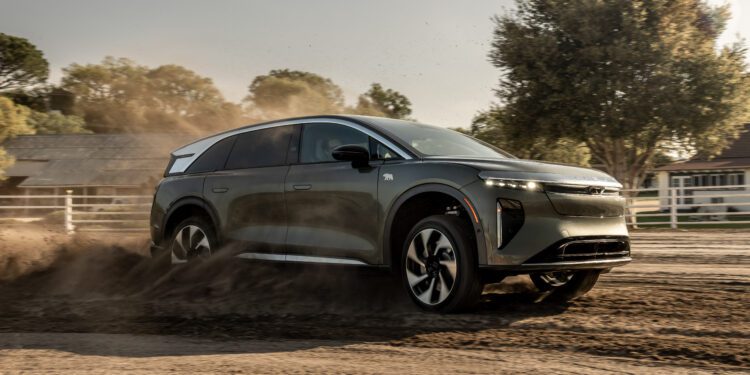
We can argue forever about what exactly was the world’s first luxury performance SUV, but I make the case that the Mercedes-Benz ML55 AMG of the early 2000s brought the concept to life. Powered by a 5.4-liter V8 developing 342 horsepower, it represented the first attempt to meld three opposing personas: a practical SUV, a luxury item, and a performance car.
In the intervening 25 years, technological advancements have allowed the performance luxury SUV to flourish. What these machines can now do from a speed perspective, whether talking about those from BMW’s M division or even the reluctant entrant that is the Ferrari Purosangue, the super SUV concept has evolved far beyond what anyone could’ve envisioned at the turn of the century.
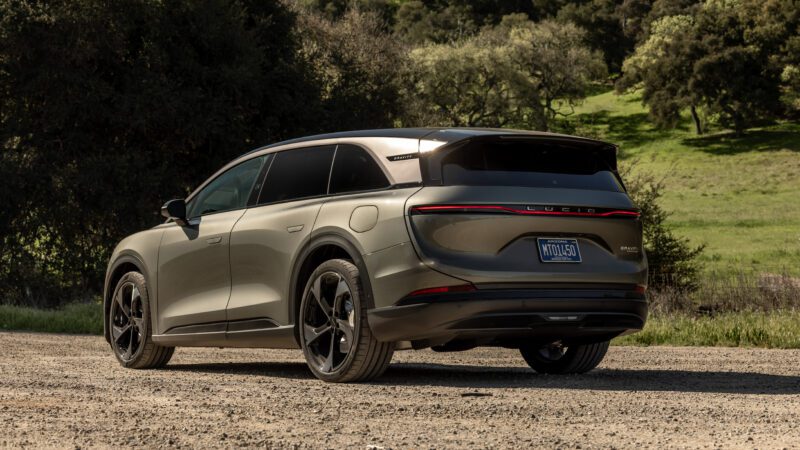
The 2026 Lucid Gravity Grand Touring, the brand’s first SUV, isn’t outwardly super. The carmaker doesn’t plan to market it primarily as a performance model like its $249,000 Air Sapphire. Instead, the $94,900 Grand Touring is merely an introduction to the Lucid SUV, with a less expensive $79,900 Touring trim due to arrive later this year and more powerful variants to follow.
Yet, while the Gravity might be Lucid’s first attempt at building a high-riding family hauler, my first drive through the twisting mountain roads of Los Olivos, CA, and a few laps of a private dirt track prove that while it may not outwardly be a luxury performance SUV, it manages to blend these opposing personas better than most.
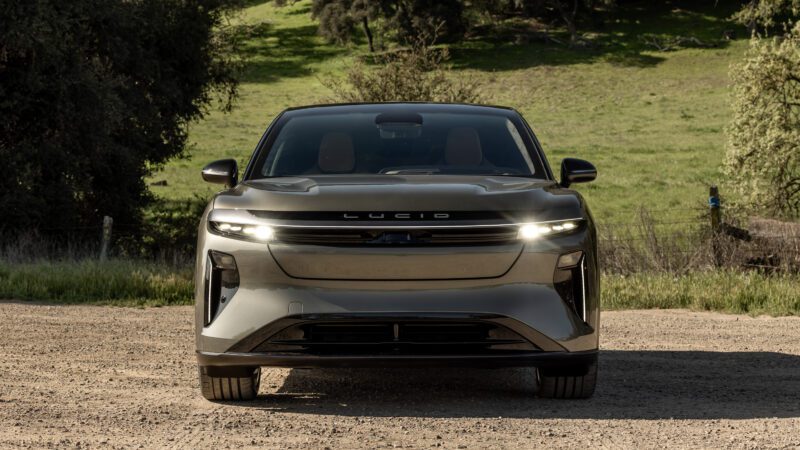
A little smack talk at a new car launch is to be expected, but Lucid doesn’t waste time mincing words. Rather than taking jabs at “our competitors” on a presentation and only vaguely alluding to what those rivals might be, the California-based brand brought out a Cadillac Escalade IQ, a BMW X7, a Rivian R1S, and a Mercedes-Benz EQS SUV. If you’re wondering where the Tesla Model X is, it’s MIA.
Still, rather than tell us that the Gravity has a smaller turning radius than its competitors thanks to its rear-axle steering system, it had us try them all back to back to experience it for ourselves. Lucid’s latest completes a turn in as little as 38 feet, compared to the IQ’s 39.4-ft figure and the R1S’s 41.3-ft radius.
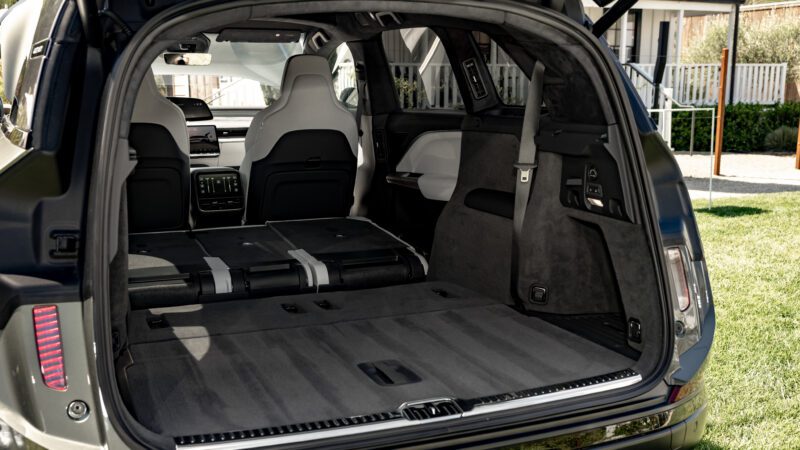
It’s a similar story when showcasing the Gravity’s storage space. Its five-seater configuration offers 120 cubic feet with its rear seats folded. This also figure takes into consideration the Lucid’s front storage compartment. Step up to the seven-seater, and that figure drops to 114.3 cu-ft, which is still enough to beat the Mercedes-Benz, the Rivian, the missing Tesla, and the BMW.
Only the massive Cadillac Escalade IQ comes close with its 119.1 cu-ft figure, which it also achieves with all seats folded. However, the Gravity matches its seating and storage space while being 26 inches shorter and four inches narrower, with a roofline that’s 11 inches lower. The real elephant in the room is the Caddy’s 9,134-pound curb weight, a staggering 3,230 lb more than the five-seater Gravity’s 5,904-lb figure (6,048 lb for the seven-seater).
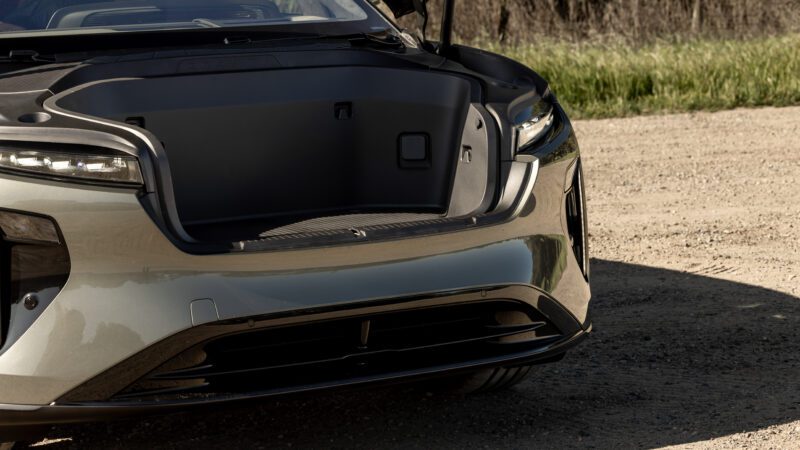
Although this SUV shares structural components with its sedan sibling, it incorporates plenty of new hardware, such as its battery pack, electric motors, charging system, and thermal system.
In a best-case scenario, a Gravity with seating for five equipped with staggered 20 and 21-inch wheels covers an EPA-estimated 450 miles, made possible by its 123-kilowatt-hour battery pack. The Grand Touring incorporates a 926-volt system that allows it to fast charge at up to 400 kilowatts. Equipped with a new NACS port with access to the broader network via adapters, the Gravity will charge up to 225 kW hooked to Tesla v3 hardware. At max speed, it’ll gain 200 miles of range in just over 10 minutes.
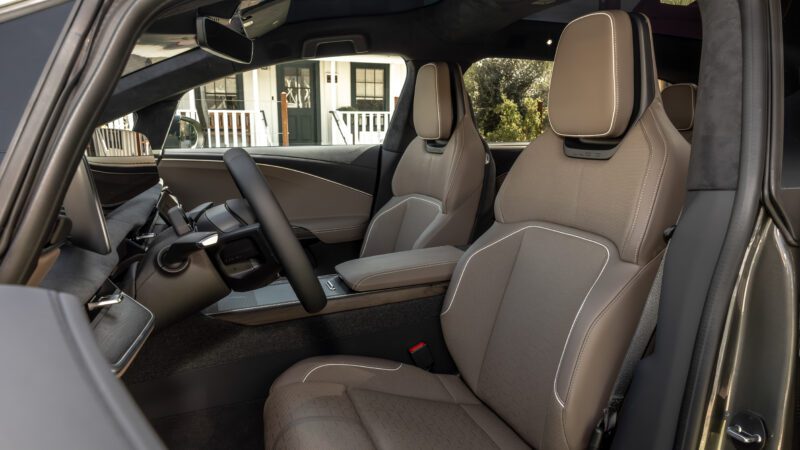
With ample seating and storage space and some of the best range/charging figures in its class, that’s the practical SUV persona covered. But what about luxury?
This $94,900 Lucid Gravity Grand Touring is the only trim available, at least for now. A $79,900 Touring model is due to follow later this year, and a Dream Edition with a rumored over 1,000 hp is expected soon after to hold the spot of the range-topping model, at least until a Sapphire-like trim arrives. As such, we’re looking at what’ll eventually be a mid-level version of the Gravity as its lineup expands.
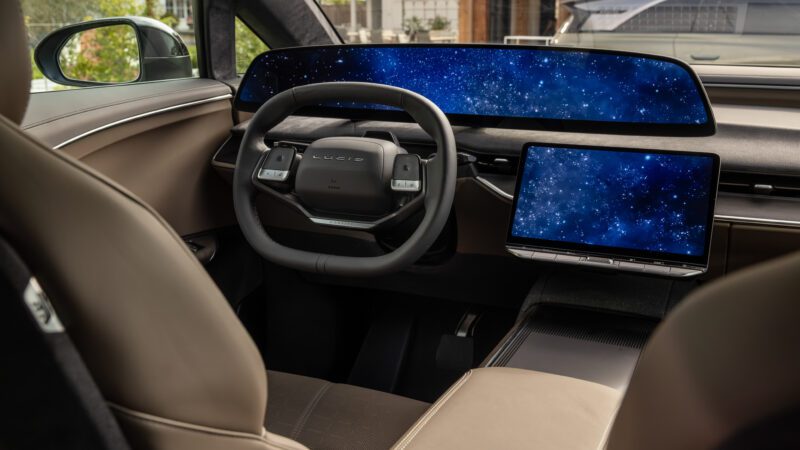
Still, while the Air leaned heavily into a screen-dense layout, the Gravity doubles down with a massive 6K-resolution OLED 34-inch central display that combines the driver’s instrument cluster and this car’s central infotainment screen. A smaller 11-inch HD OLED screen lives on the dashboard and incorporates physical switches for the controls you interact with most, such as this car’s A/C settings. A third seven-inch screen offers climate adjustment for those in the second row.
A cluster of screens isn’t necessarily synonymous with luxury, see the Bugatti Tourbillon and the lengths it goes to avoid them. However, for such a vehicle defined by its software, they’re essential to the experience the Lucid Gravity Grand Touring aims to deliver.
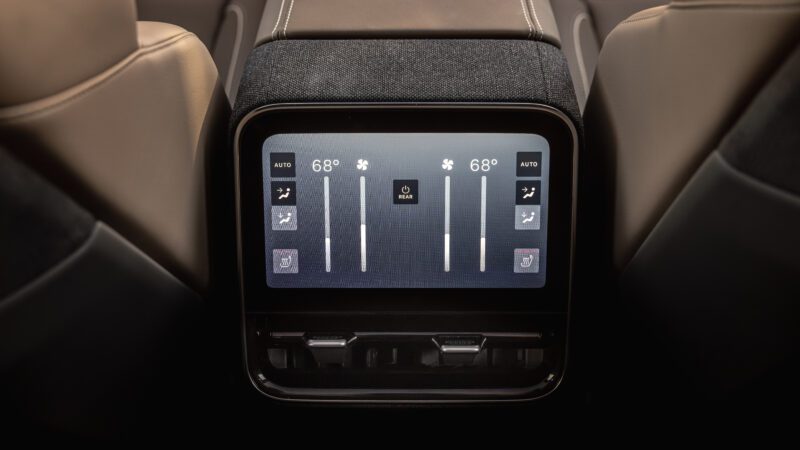
As I settle behind its squared-off wheel for the first time, a decision made so you have an unobstructed view of the main display, it’s all a bit overwhelming. It takes a few minutes to find where this SUV’s controls and adjustments hide, especially as they differ entirely from competitors. However, this foreignness creates the sense that you’re not driving just another luxury SUV from established brands like BMW, Mercedes-Benz, and Audi. The Gravity feels fresh in a segment that’s gone stale by closely copying each other’s homework.
There’s plenty to like from a materials standpoint as well. At launch, the Lucid Gravity Grand Touring is available with four pre-configured interior themes modeled after various regions of the Californian outdoors. Build quality feels excellent, and the cabin remains nicely isolated from excess wind and road noise at higher speeds. However, don’t expect vibrant color options to come any time soon. It’s a similar story when considering this car’s exterior palette, which is decidedly muted, with the best of the bunch being the Aurora Green shade my tester wears.
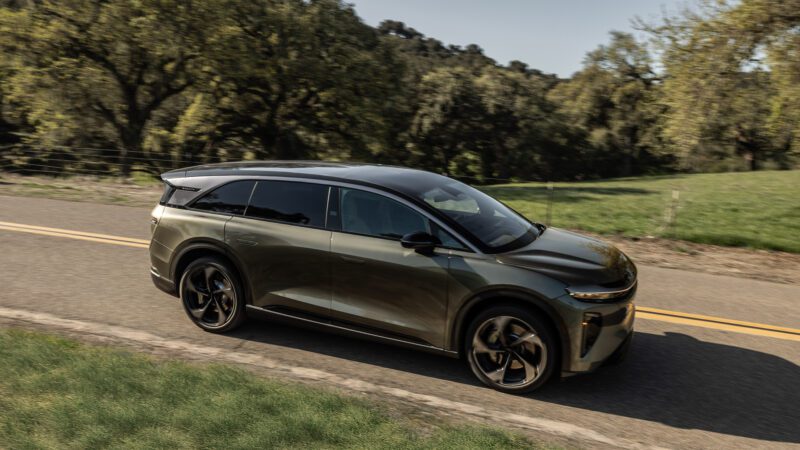
As groundbreaking as the Gravity is in terms of technology and its packaging, I suspect its exterior design will be too polarizing for the traditional luxury SUV buyer. While Lucid undoubtedly primarily targets a tech-forward customer, it needs to move units, which means also converting the Range Rover and G-Wagen crowd. And while the carmaker did make an effort to adorn this SUV with a sleek aesthetic, the Gravity suffers from minivan-like proportions, a vibe that doesn’t scream “luxury item.”
However, if you’re into it, the Lucid Gravity Grand Touring makes up ground with its three-chamber air suspension, offered as part of the $2,900 Dynamic Handling Package. It rises to provide up to 9.3 inches of ground clearance in its highest setting, nearly matching a Mercedes-Benz G550. In its sportiest setting, it’ll squat down to 5.2 inches to better match the handling characteristics of the Air sedan.
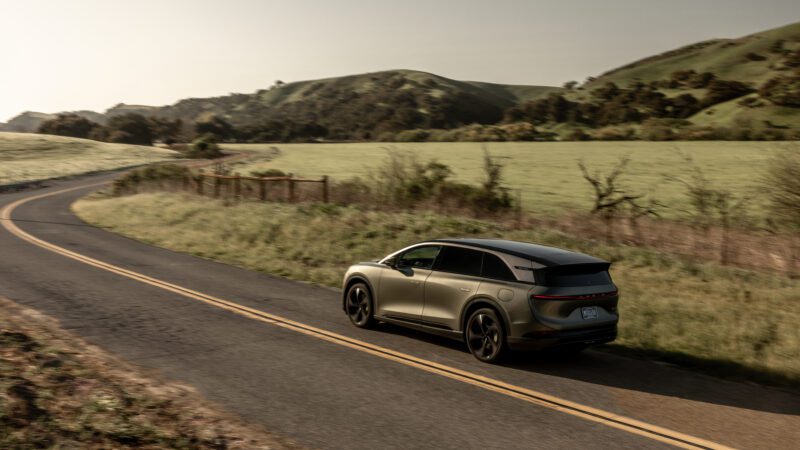
In the softest Smooth mode, it rides beautifully, effortlessly soaking up road imperfections while transmitting virtually no harshness to its passengers over rougher road surfaces. Paired with a well-isolated cabin, the Gravity is practically faultless if a luxury driving experience is what you’re after.
For those who want more, however, the Gravity has a final ace: its ability to morph into an actual performance vehicle. As difficult as that might be to believe now that you’ve learned how much tech, space, and weight is packed into this three-row SUV, a drive on a winding mountain road chasing Lucid’s Senior Director of Chassis & Vehicle Dynamic Engineering, David Lickfold, proved that not even a $249,000 Air Sapphire with 1,234 hp can leave the Gravity behind.
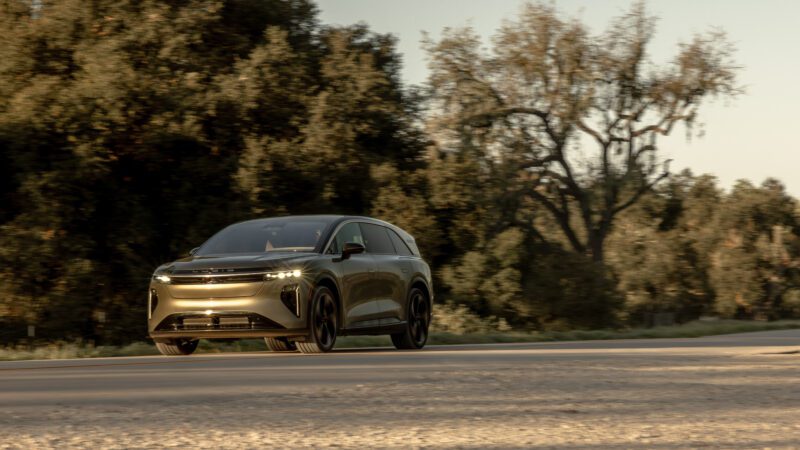
This becomes more believable as you learn that the Lucid Gravity Grand Touring develops 828 hp and 909 pound-feet of torque, split between two electric motors that send that power to all four wheels. Flat out, this near 6,000-lb SUV sprints to 60 mph in 3.4 seconds, besting even a rear-drive Lamborghini Huracan EVO Spyder.
Alongside its air suspension, which drops in the middle Swift setting and truly squats in the most aggressive Sprint mode, the Gravity gets its stopping power from six-piston Brembo brakes up front with a four-piston set in the rear. It’ll torque vector using its brakes and puts the power down via Lucid’s in-house developed traction control system.
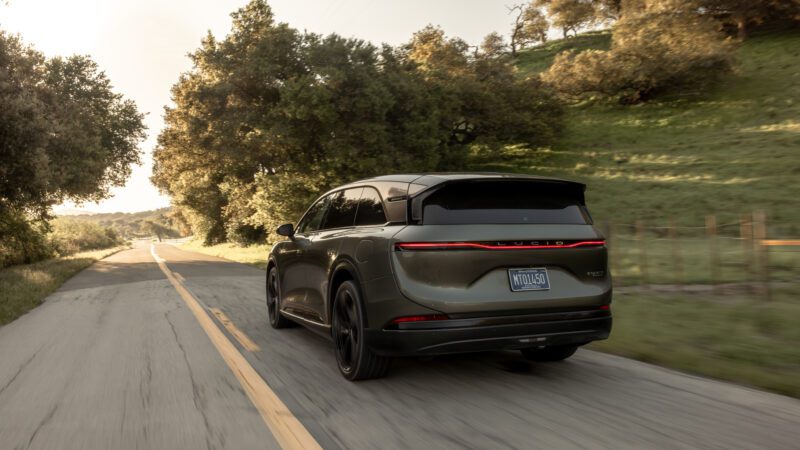
On a back road, its straight-line performance is dramatic, as expected from most EVs. What is surprising, however, is just how well the Lucid Gravity Grand Touring tackles the bends. It changes direction like something that weighs 1,000 fewer pounds. Simultaneously, its steering, despite being electrically assisted, is precise, quick, and even picks up a fair bit of weight under load. It’s a feat no BMW M car, Audi RS product, or any of AMG’s latest seem to match. It’s Porsche-like in its tuning, which, as far as electric steering goes, is the best in the business.
Because Lucid allows you to adjust your regenerative braking settings independently from your drive mode, you can fine-tune how much you want to help this SUV’s brakes when the road starts to wind. After a few minutes of running at a decent pace with no regen enabled, however, I did feel the brakes begin to struggle, such are the limitations of a nearly 6,000-lb vehicle on a mountain road.
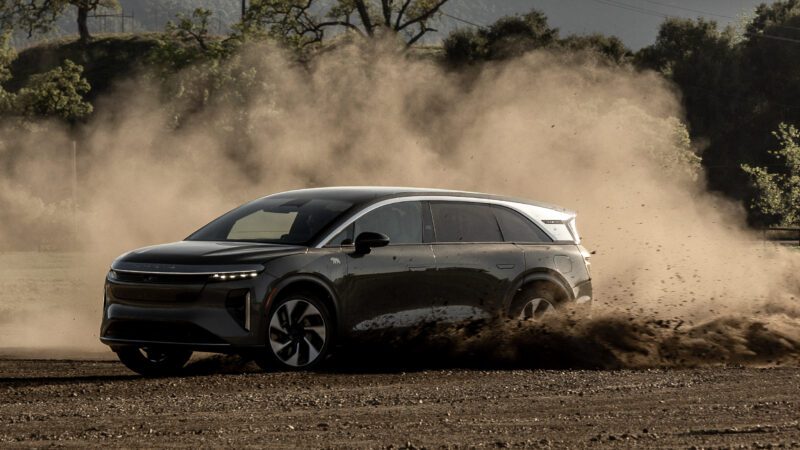
While the Gravity’s ride quality suffers in the top Sprint setting, it pays dividends regarding backroad performance. It’s stable at speed and effortlessly settles its weight as you transition from bend to bend. Towards the end of my time on the twisty road, as I approached the final stop of the day, I was left feeling that a family SUV shouldn’t be this quick in a straight line, so agile in the bends, or so engaging to drive, yet the Gravity manages it.
Although not yet available, Lucid plans to offer a dedicated off-road mode for the Gravity as part of a software update to further enhance this SUV’s capabilities. For now, however, with a private track at my disposal and a prototype version of this drive setting, a quick run on dirt quickly morphed into an impromptu drift session. Lucid’s engineers had mentioned that the Gravity has a rear-biased power distribution. Still, here it’s evident as this family hauler kicks up clouds of dirt, hangs its tail out, and, with plenty of power, reaches extreme angles while sideways.
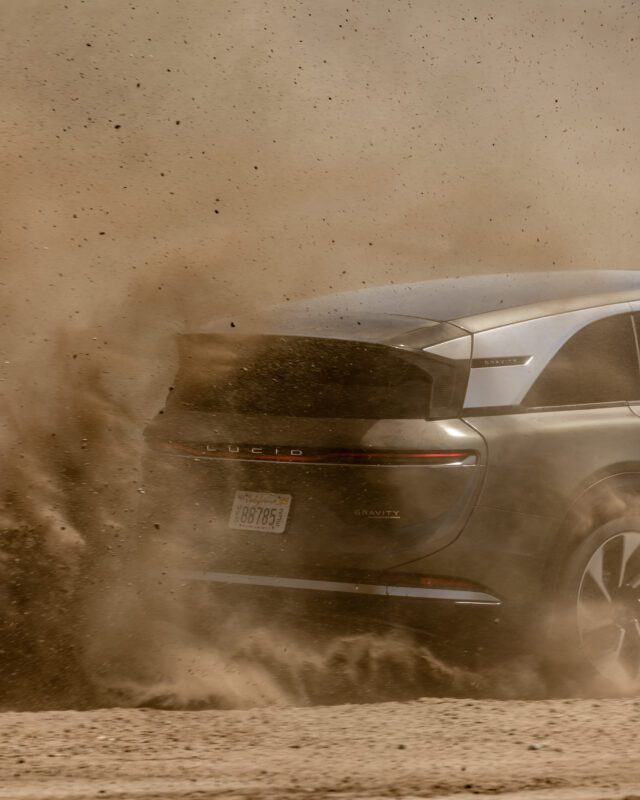
Its quick steering comes into play, allowing you to make quick corrections while getting a clear sense of exactly where its front wheels point at any given moment. Again, the feeling that an SUV shouldn’t be this athletic or this exciting to drive creeps in again. Consider the Gravity’s sporting credentials confirmed.
As you likely picked up in the earlier portions of this piece, the Lucid Gravity Grand Touring is a technological powerhouse, one the carmaker aims to improve through regular updates. From an electric family SUV perspective, Gravity excels thanks to its segment-leading storage and passenger space alongside its excellent range and electric efficiency.
If you see it as a luxury item, Lucid’s first SUV impresses with its tech-filled cabin, excellent material choices, and well-isolated cabin. Paired with a plush air suspension setup, the resulting driving experience feels luxurious, even if its minivan-like looks don’t quite reinforce the feeling.
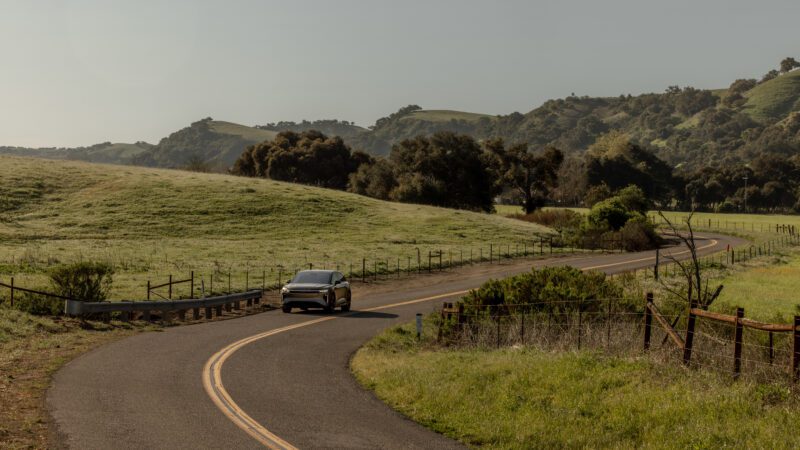
However, what’s most shocking is how genuinely sporty the Grand Touring manages to be. Its weight and size make it tremendously quick, exciting to drive, and outrageously capable. It feels like a proper performance vehicle in a way that most competitors don’t.
The Gravity manages to split its personalities in ways the ML55 AMG that kicked off the segment could only dream of. Lucid’s second act doesn’t just show how far the performance SUV has come; it enters the space ready to lead it.
Review: The 2025 Mercedes-AMG G63 Offroad Pro Is the Ultimate G
by Gabriel Vega
in Reviews
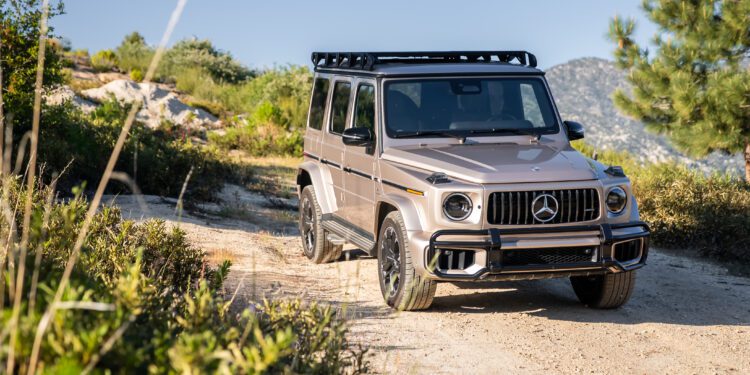
Few proper off-roaders can match the Geländewagen’s range. Despite its ability to tackle rugged trails out of the box, thanks partly to its body-on-frame build, three locking differentials, and long-travel suspension, the G-Class can just as easily crawl the streets of Beverly Hills without looking out of place. It’s this versatility, its boxy looks, and its visibility as a status symbol that have granted this SUV its icon status.
Today, the Mercedes-AMG G63 remains the flagship G-Class. And because the G580 is powered by batteries and the G550 by an inline-six, it’s also the only version of this off-roader offered with eight cylinders under its hood. However, while most G63s ride on rubber band tires and large wheels, the one I’m in this week embraces a more rugged approach thanks to its optional $13,450 Offroad Package Pro upgrade.
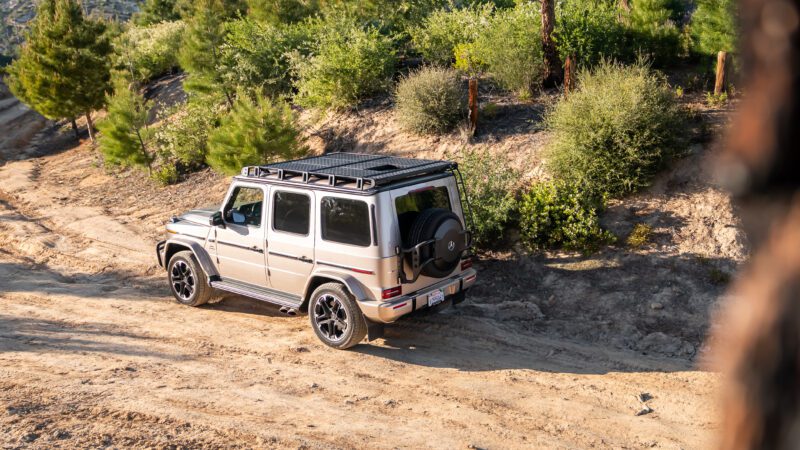
With a roof rack, mud flaps, and a smaller 20-inch wheelset wrapped in more off-road-focused tires, this G63 finallyadopts an aesthetic that matches its capabilities. And as you’ll soon learn, it doesn’t sacrifice its on-road performance to do it.
The G-Class is in a strange spot at the moment. The G550 I drove a few weeks ago left me missing its discontinued V8 more than loving the inline-six that replaced it. The G580 I tested before that proved to be a fantastic first crack at a battery-powered G. Yet despite its tremendous performance, clever off-road tech, and stellar ride quality, new reports suggest that it’s not flying off the shelves quite as Mercedes had hoped.
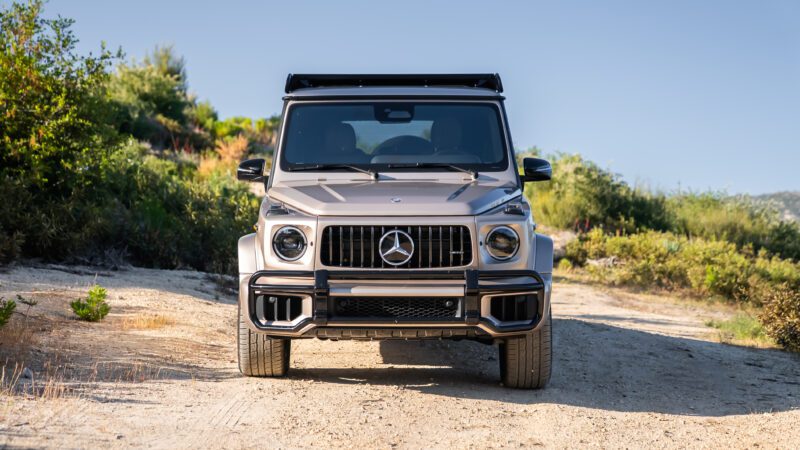
The fact that I had to wait a bit to get into the new Mercedes-AMG G63 ultimately turned out to be a blessing in disguise. From the moment you press its start button and hear its V8 rumble to when you hear the sound of its iconic door latch, the G63 feels like the most authentic G-Class on sale. Starting at $187,250, including a $1,150 destination fee, it’s also the most expensive, but more on that later.
The Geländewagen is defined by its ability to create a sense of occasion, and that’s precisely the area the $13,450 Offroad Pro package improves. Like the rest of the G-Class lineup, the G63 receives some subtle exterior updates for the 2025 model year, with most of the changes residing in its restyled front and rear bumpers. The eagle-eyed among you might also notice that its rear-view camera now sits above its license plate.
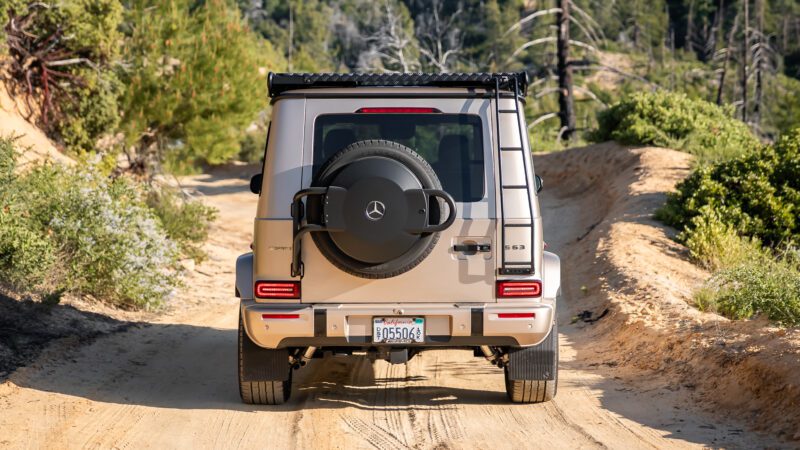
The Offroad Pro package forgoes any sense of subtlety. It starts with a metal roof rack complete with a small ladder bolted to this truck’s rear quarter panel. Its spare wheel holder also gets upgraded from plastic to metal, sporting the same textured black finish as the rest of the new gear. You’ll spot front and rear underguards adorning its bumpers and mud flaps positioned just behind its 20-inch wheels.
This look suits the Geländewagen’s spirit perfectly, and much like the rest of this SUV’s appeal, you don’t have to leave paved roads to appreciate it. Simply put, it looks stellar. Even if you never pitch a tent on the roof or see how far its General Grabber HTS rubber will take you, you can still enjoy how this optional package takes an SUV with a strong stylistic pull and strengthens its ability to draw you in.
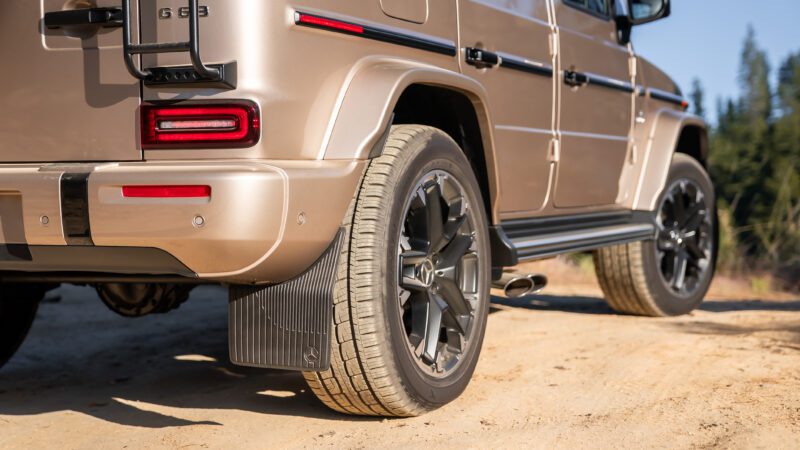
The final piece that makes up this optional package is perhaps the most important: its inclusion of AMG’s Active Ride Control suspension. Offered solely for the Mercedes-AMG G63, this is an active system that relies on hydraulics rather than anti-roll bars to eliminate excess lateral body movement. The suspension’s four dampers are hydraulically linked, with each damper featuring connections on both the damper and rebound sides.
As such, the system can respond instantly to bumps or road undulations by adjusting each corner of the suspension independently. The result is a tall SUV that weighs 5,842 pounds but still manages to tackle corners without giving you the impression that it’s ever ready to topple over. It’s a significant improvement in terms of stability over the outgoing Mercedes-AMG G63, making this newest model both more balanced and fun to drive.
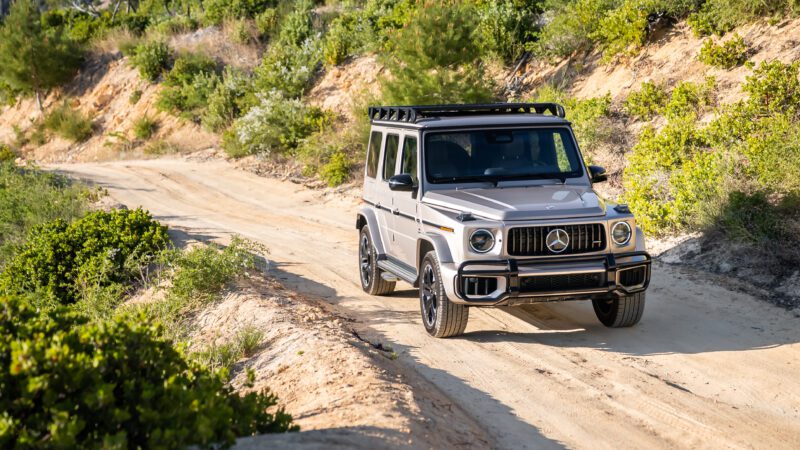
More importantly, the system gives its driver a higher sense of confidence when deploying this truck’s 577 horsepower and 627 pound-feet of torque output. It squats less under hard acceleration while also significantly reducing nose-dive under braking. AMG’s 4.0-liter twin-turbocharged V8 happily sings its burbly muscle car tune through its side-mounted exhaust tips while a quick-shifting nine-speed automatic transmission and a permanent all-wheel drive system make it feel every bit as potent as its stats suggest.
The G63 has never had a power problem, and with this latest model sprinting to 60 mph in 4.2 seconds, neither does this one. However, its optional active suspension allows you to explore far more of it than previous iterations. Yet even as you approach a bend, this truck’s upsized have no issue slowing it while its steering remains totally numb from a feedback perspective but picks up some newfound precision.
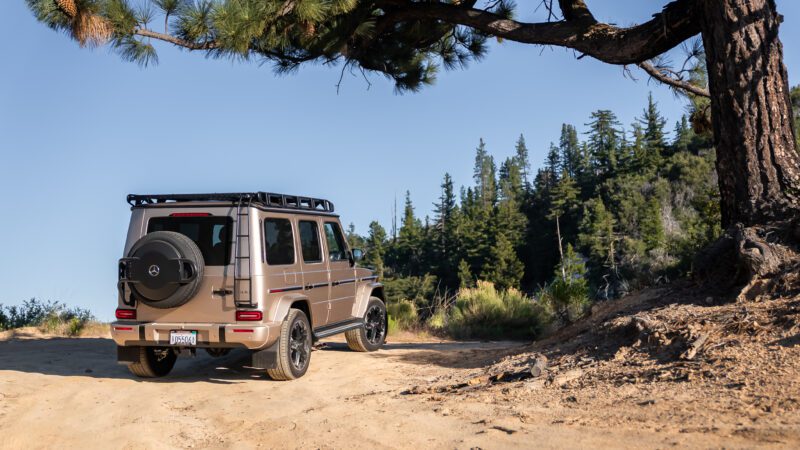
Crucially, the Mercedes-AMG G63 achieves this without diminishing its on-road comfort or daily usability. Instead, this active system and thicker tire sidewalls improve it. While its predecessor didn’t ride harshly, this latest model makes notable improvements, bringing the G’s ride quality closer to what you’d expect from a Range Rover. Of course, achieving this means giving up some of the old-school rugged and truck-like feel the G-Class is known for, but to all but the most hardcore fans, this will come across as a significant step forward.
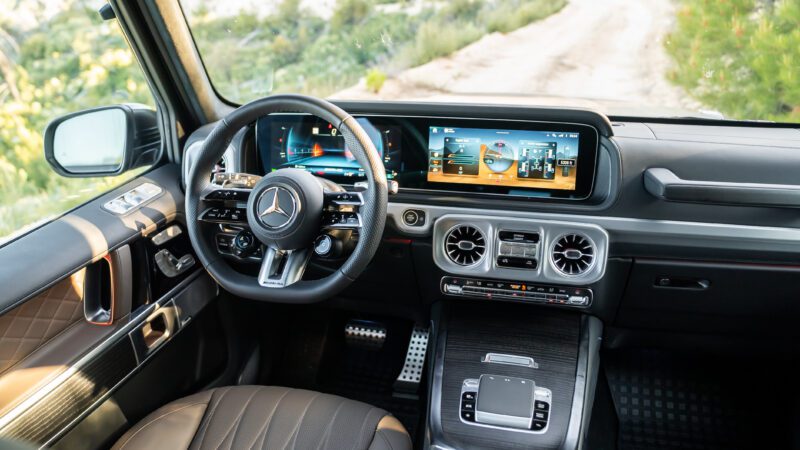
Inside, the Mercedes-AMG G63 continues the subtle upgrade trend. This tester features a classy Tartufo Brown finish on its seats, complementing the black leather used on its dashboard and steering wheel. A $1,300 ash wood trim option further elevates the cabin, which pairs well with this SUV’s $6,500 Desert Silver metallic exterior finish and its $2,350 AMG Night Package overall.
On the tech side, its twin 12.3-inch instrument cluster and infotainment displays might seem unchanged at first glance, but they house Mercedes’ new Offroad Cockpit. It’s a system designed for use primarily on trails, providing vital data at a glance, such as altitude, steering angle, and the vehicle’s position as the road grade changes. It’ll also allow you to use the G’s cameras to see a clear view of the road ahead and any upcoming rocks or debris.
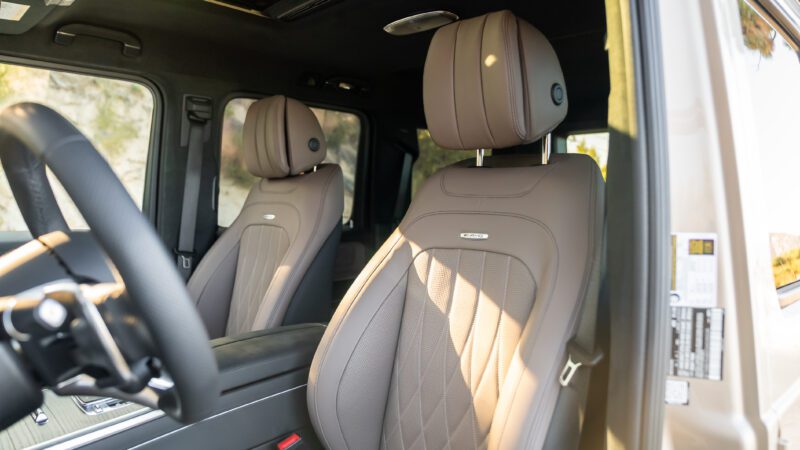
The Offroad Package’s biggest flaw becomes apparent once you’re behind the wheel, namely its increased wind noise at highway speeds. Although tire noise doesn’t increase significantly, the sound generated by this truck’s roof-mounted platform surely does. It’s enough to be distracting, requiring you to turn up your music a few clicks higher than you usually would. If a whisper-quiet cabin is what you’re after, this rugged G isn’t for you.
As I mentioned earlier, the Mercedes-AMG G63 remains the flagship model, starting at $187,250. For context, the G550 I reviewed earlier this year has a base price of $149,400, while the electrified G580 comes in at $162,650. Factor in optional extras like the $13,450 Offroad Package Pro, $7,400 Exclusive Interior Plus, and its $2,350 AMG Night Package, and this truck’s as-tested price balloons to $220,300.
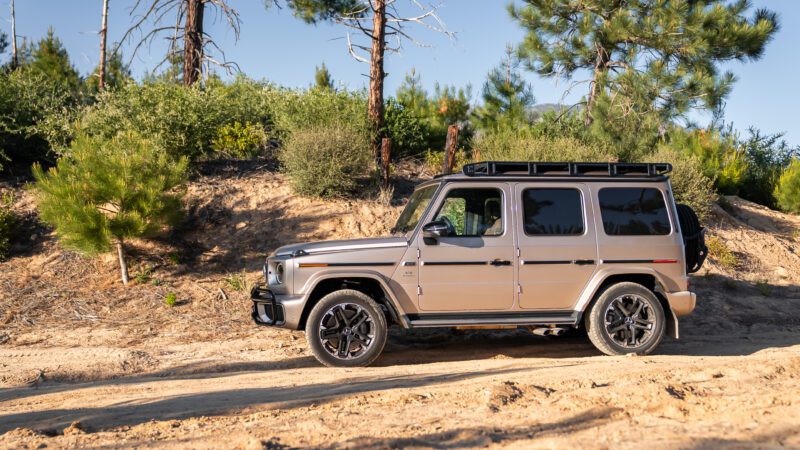
The G63 is an off-roader defined by its ability to create a sense of occasion, and the Offroad Package Pro only strengthens its ability to do so. Despite its added ruggedness, it allows this AMG to retain its ability to fit in anywhere. However, the upsides from an aesthetic perspective are significant. This SUV now has looks that match its off-road capability much better than in its more common form, featuring large wheels and tires with thick sidewalls.
However, what’s most impressive is just how well the G63’s active suspension improves both its high-speed stability and ride quality without significantly detracting from the G-Class experience. While the G550 takes a step back and the G580 struggles to catch on, the Mercedes-AMG G63 remains the ultimate G-Class.



